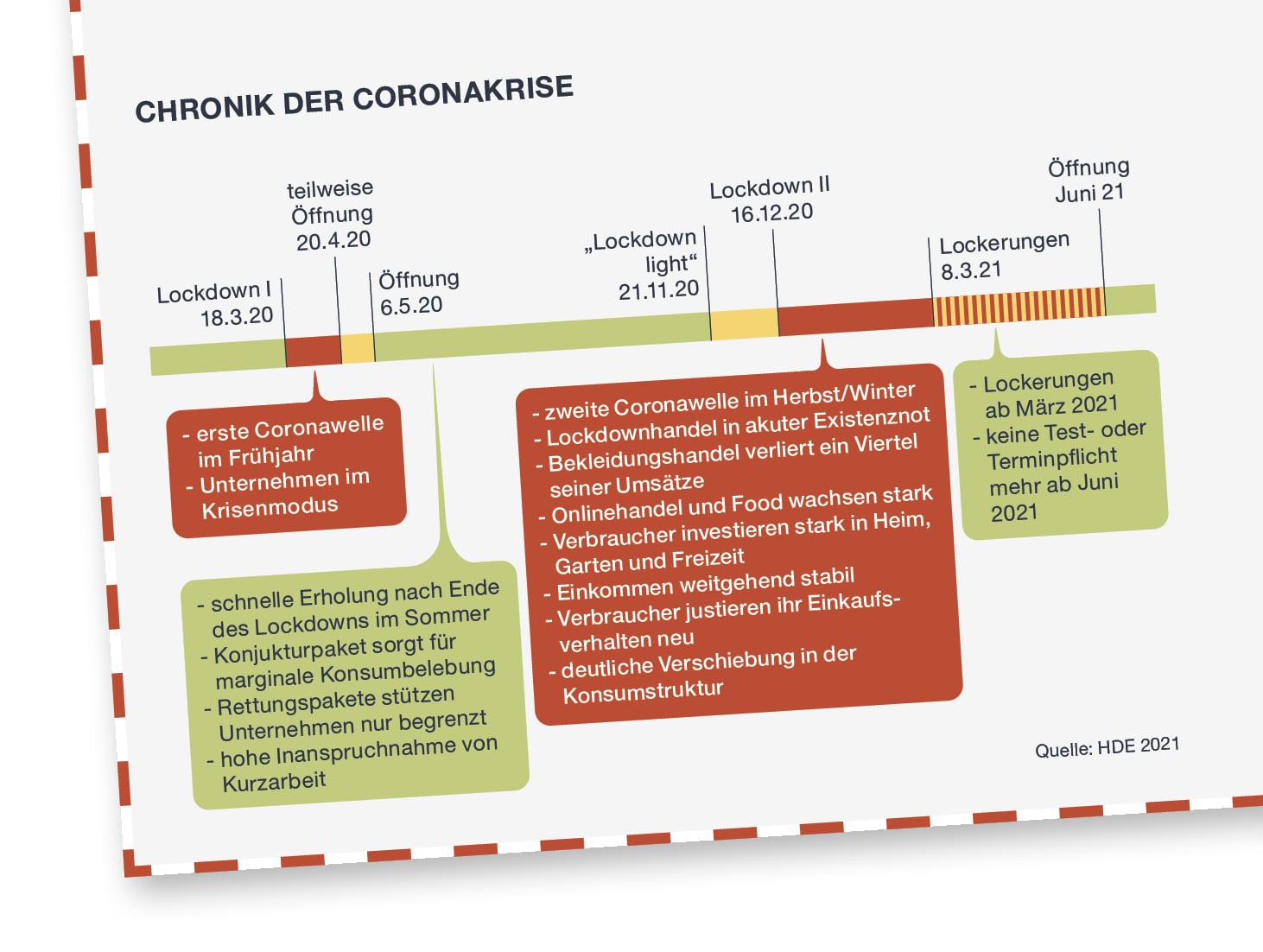- 22. February 2022
Start and stop
Overall, retail parks in Germany have weathered the 2020/2021 corona crisis better than their relatives - shopping centers in city centers. Nevertheless, changes of use and tenants are necessary at many locations, sometimes even a complete restart. German construction planning law complicates and administrations delay this change process. Only a significant streamlining of regulations and laws and an acceleration program for public procedures will help to convert retail parks in a way that is appropriate for consumers.
Trigger for the need for repair
In the past 15 months, the German retail sector has undergone an unprecedented bloodletting, which in retrospect is best illustrated by the chronicle of the Corona crisis. In particular, the phase from the so-called "lockdown light" at the beginning of November 2020 to the reopening in June 2021 has led to a serious culling process, especially in the area of specialty stores in the fashion retail sector. If we take the latest forecasts from the HDE, stationary textile retail sales in 2021 will be almost 40 percent below those of 2019. In other words, the departure of numerous market players in the retail sector can also be expected in the coming months. The fact that retail parks are on the move on the tenant side was already clearly discussed last year in connection with the new use of the Real hypermarkets in Germany. In this respect, two main drivers for the refurbishments and new starts of the retail parks are now coming to bear, namely
- • the subsequent occupancy of the (Real) hypermarkets and
- • the corona-related restructuring of space to be reoccupied as a result of specialist store tenants going out of business.
Pattern for reassignment
In the majority of cases, the area of the previous hypermarket is divided into several rental units. This means that one or more specialist stores are added alongside the new consumer market or hypermarket, which is significantly smaller than before.
The existing building planning law at the site, which is usually very restrictive and linked to the original use, does not normally permit this use. The basic possible solutions are:
- • the achievement of exemption from the textual provisions of the development plan (§31 BauGB), provided that the basic principles of planning are not affected,
- • The amendment of the existing development plan on the basis of an impact assessment,
- • the new preparation of a development plan, which replaces the previous development plan, or
- • the approval of the new project on the basis of §34 BauGB if the existing development plan is ineffective. We have reported on this case constellation time and again in recent years.

A new development plan? Now even more complicated
In addition to a lengthy amendment of the existing development plan, there is therefore (theoretically) still the option of drawing up a new development plan that takes into account today's requirements. This initially involves avoiding the area-related sales area stipulations. This is because the fundamental decision of the Federal Administrative Court in the Eckernförde ruling of 2008 (4 CN 3.07) means that there is no authorization to set building area-related quotas for possible uses.
Now everything has become even more complicated: In its most recent decision of October 2019 on retail control via special area determinations, the Federal Administrative Court ruled that a restriction on the number of permissible projects in another special area is also invalid for lack of a legal basis (see BVerwG, Urt. 4 CN 8.18). A numerical restriction of permissible facilities does not contribute to the identification of the type of permissible use. It does not qualify a type of facility, but quantifies options for use.
At the same time, however, the Federal Administrative Court also reiterated that municipalities are permitted to designate special areas for large-scale retail uses and, in doing so, to make specific regulations on the maximum sales area according to square meter limits. Such regulations are regulations on the type of building use. This also applies to shopping centers and thus also to retail parks. In addition to the stipulation of maximum sales areas, the stipulation of a minimum sales area or minimum sales areas for certain product ranges is also permissible.
Let's summarize:
- • The legally compliant design of textual provisions for new development plans has become even more demanding and ultimately more complicated.
- • Area-related sales area specifications remain inadmissible.
- • A restriction on the number of permissible projects is legally invalid. A numerical restriction of permissible facilities or types of operations of large-scale retail trade is also impermissible.
- • In addition to the legally permissible definition of maximum sales areas, overall or by assortment, the definition of minimum sales areas in new development plans is becoming increasingly important.
Result:
The redrafting of a development plan is not suitable, also due to the increased complexity of the requirements, for the speedy and successful implementation of tenant changes in the retail park and, at the same time, for curing a recognizably ineffective development plan.
Experiences from the current projects
Experience from current projects shows that an amendment to an existing development plan cannot be prioritized with a time requirement of 18 to 24 months and a high risk of failure.
In this respect, it is still worthwhile to proceed either with the immediate approvability of the restructuring on the basis of the existing development plan (reserves in the development plan) or on the basis of an ineffective development plan and the assessment according to §34 BauGB (unplanned inner area).
However, the most widespread form of exemption from the textual provisions of the development plan remains on the basis of Section 31 BauGB. Provided that the basic principles of planning are not affected, expert evidence of the justifiability in terms of urban development can help,
- • both significantly accelerate the process and
- • to achieve a face-saving solution between the developer and the local community.
Demands on politicians after the Bundestag elections
In light of these challenges, we have the following demands for the term of office of the new federal government:
Objectively, retail parks perform an important task, especially for a modern, efficient local supply of the population. Because successful cities will continue to need strong retail parks in the future, they should also be given the necessary appreciation and opportunity for further development in municipal retail and center concepts.
The existing procedures in the administration must be accelerated significantly. Here, all possibilities of digitization (digital development plan procedure) must be exploited.
The ruling of the European Court of Justice in the Appingedam/Visser case should finally be taken seriously. As much planning as necessary, as little restriction as possible - that should be the motto when dealing with the repair and revitalization of retail parks.
The monitoring of development plans should be introduced now. This is because textual stipulations for the "protection of the urban environment" (protection of city centers and other central supply areas) are only required for as long as it is necessary to achieve the objectives. In other words, it is mandatory that development plans be reviewed after ten years at the latest.
By Uwe Seidel, Dr. Lademann & Partner


